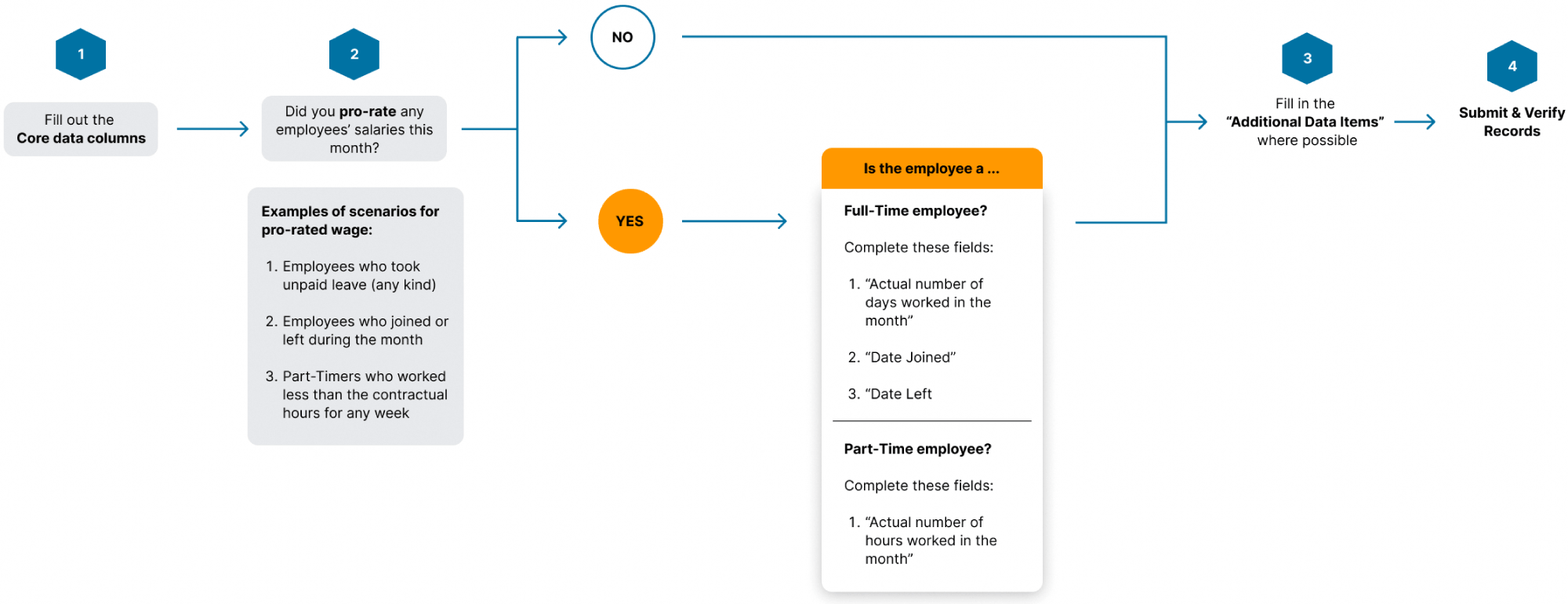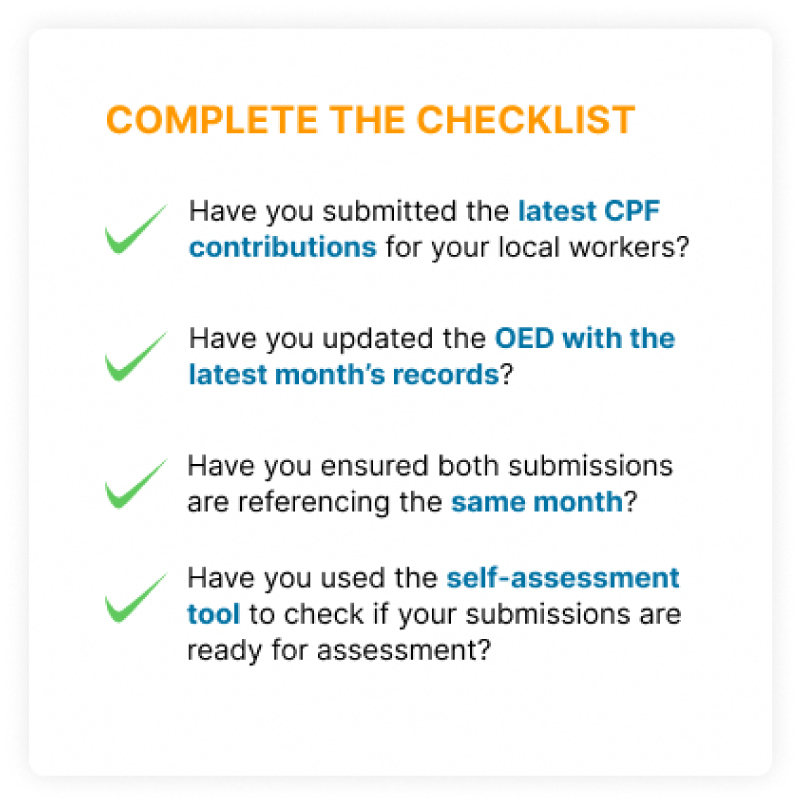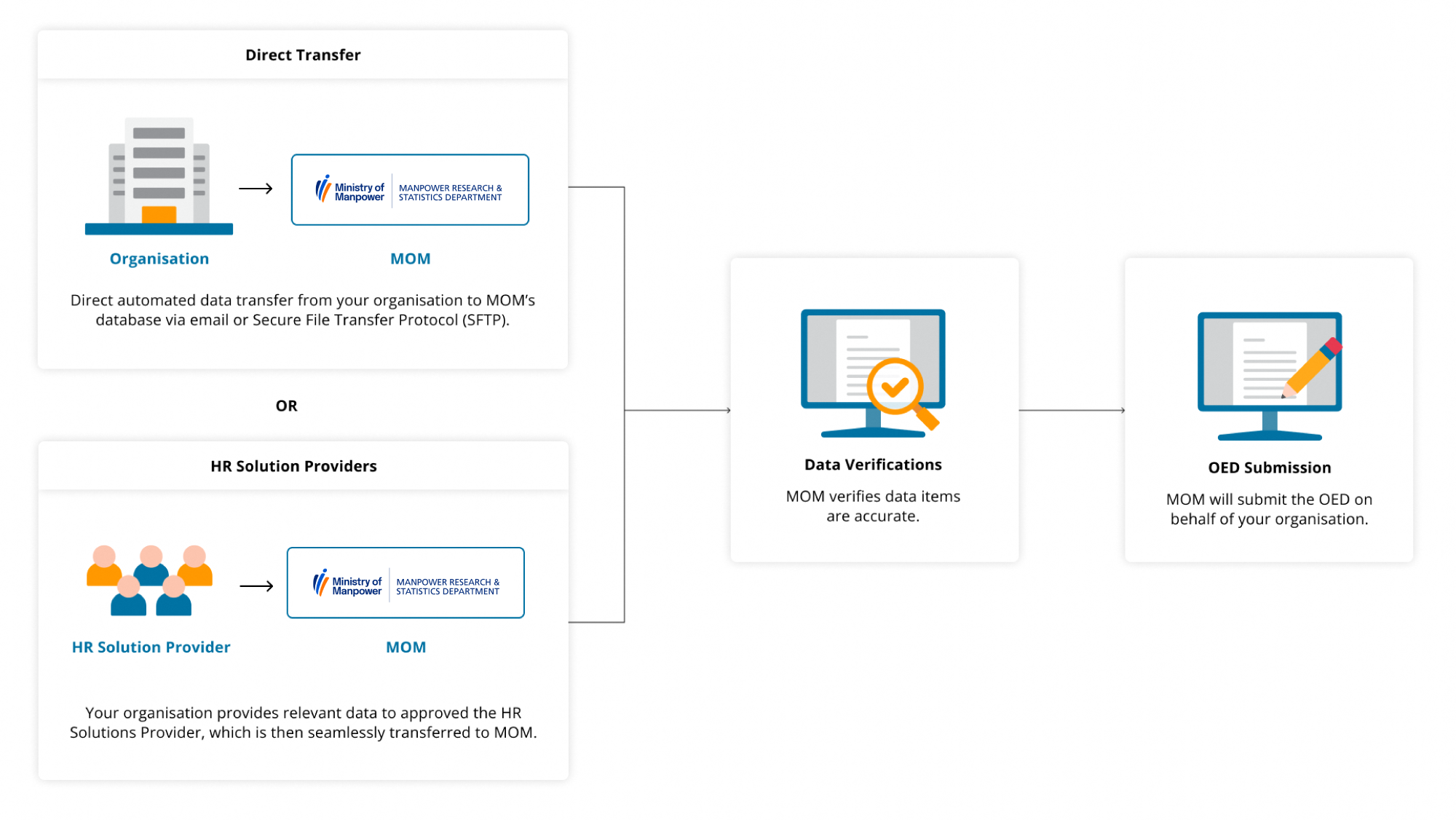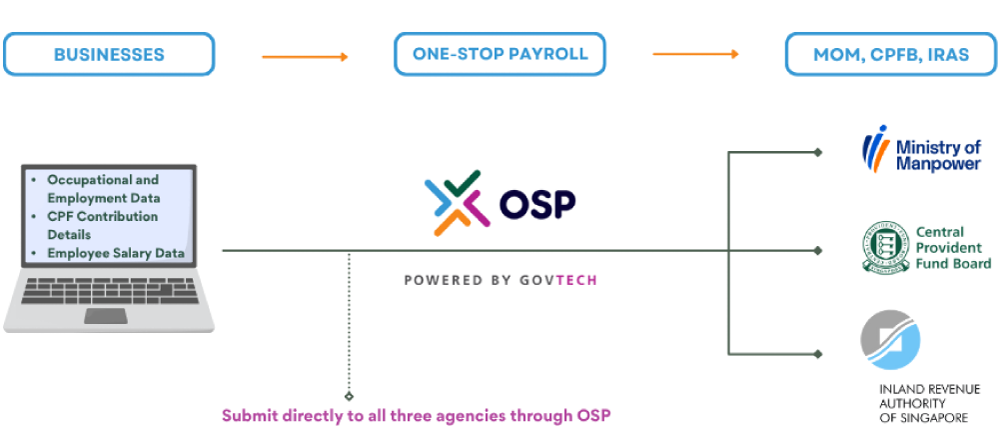What is the OED?
What is the Occupational Employment Dataset (OED)?
The Occupational Employment Dataset (OED) is an online registry that collects the occupational and employment data of current workers in Singapore. All registered businesses are required to provide the latest occupational and employment details of all employees (Citizens, Permanent Residents, and Foreigners) under their payroll to the Ministry of Manpower (MOM).
For more information on all the data collected, please refer to the
OED Glossary.
Why do I need to provide the information collected under the OED?
By regularly compiling comprehensive occupational and employment data through the OED, it will provide valuable insights that aid in the review of manpower policies. These policies directly affect all businesses and workers in Singapore.
In addition, with complete and regularly updated OED data on organisations, MOM endeavours to use these data to complete quantitative questions in other manpower surveys such as the quarterly Labour Market Survey (LMS). This can help reduce the survey load on organisations.
OED data will also be used to assess whether organisations have met the Progressive Wage (PW) and Local Qualifying Salary (LQS) requirements. Firms that do not comply with the requirements will not be able to renew existing work passes or apply for new work passes.
How to update the OED


Step 1 – Complete Core data columns
If there no applicable PW workers, choose the ‘Not Applicable’ option from the dropdown list under the PWM Job Level Column.
Step 2 – Complete Secondary data columns
For employees who did not receive pro-rated salaries for the month, please proceed to Step 3.
For employees who have received pro-rated salaries for the month, you will need to complete the following based on their Full-Time or Part-Time employment contract status:
Full-Time employees:
|
Part-Time employees: |
- Actual number of days worked in the month
- Date joined
- Date left
| - Actual number of hours worked in the month
|
Step 3 – Fill in the ‘Additional Data Items’ where possible.
Step 4 – Submit and verify your records.
You may refer to the
OED Navigation Guide to guide you through the OED submission process.
How do I login to the portal to update my OED information?
Step 1 - Log in to the OED portal:
- Log in to the
OED portal
- At the login page, under the OED section, select “Log in to OED”, followed by “For Companies”
- Log in with your Singpass
Step 2 - Update or create OED records:
- A pop-up will appear to direct you to the OED Submission page. If the pop-up does not appear, click on the “Occupational Employment Dataset (OED)” tab, followed by “Proceed”
-
Click on “Update OED”
- You may update your OED either online using a web browser or offline using Excel
We recommend you to edit your OED records offline in Excel if you have multiple employees
- To create or edit offline in Excel, select “Download Records to Edit” under the “Edit Offline in Excel” section
An Excel file titled “Employee Listing” of the latest version will be downloaded
- You may refer to our
OED Glossary for the information you need to provide
Step 3 - Submit your updated OED records:
- Select “Upload Records” on the OED submission page
- Under Email ID, provide an email address for the system to update the user on the status of their OED submission
If you enter an email address that is not yours, please inform the respective individual as the email will be sent to their email address
- Drag and drop the updated file or attach the file by clicking “Select File(s)”
Please ensure that the File Name is saved as your company’s UEN and only contains alphanumeric characters (no spaces or special characters). - Click on “Attach” to upload the Employee Listing
- An email on the status of the OED submission will be sent to the email keyed under Email ID
Step 4 - Rectify any record(s) with errors before submitting your OED again.
You may refer to the
OED Navigation Guide to guide you through the OED submission process as well as to identify solutions for any validation errors you may face.
For enquiries on Wage Access, refer to our
Additional Information Section
How can I verify if I had successfully submitted my OED?
There are 2 ways to verify your submission:
- Once you have submitted the OED on the portal, please wait and refresh the page to view the changes made. Any records that appear in red indicate errors that need to be corrected immediately for the OED to be considered as a successful submission.
- If you have completed the submission of the OED by uploading the company's employee listing file, an email will be sent to the provided email address, specifying the number of validated record(s) and record(s) with errors.
If there are validation errors, you will need to rectify any error(s) and resubmit your OED via either of the following 2 ways:
- Edit the record(s) with errors directly on the browser
- Download the OED from the OED portal under “Download Records to Edit” to generate the updated listing. The type of errors to be rectified will be reflected in the last two columns of this new listing. You will need to edit these errors and re-submit the listing again.
You may refer to our
OED Navigation Guide for solutions to common record error scenarios.
When do I need to submit the OED?
Your organisation is required to update the OED as and when there are changes to the occupational and employment details of your employees.
If there are no changes in the new month, our system will rely on the OED records that were previously submitted.
I have questions regarding the OED. Who can I contact?
You may call our hotline at 6320 7722 from Monday to Friday (excluding public holidays), 8:30am to 5:30pm, or send us an email enquiry at mom_oed@mom.gov.sg. Please indicate the UEN of your organisation in the email subject line.
Alternatively, you may leave an enquiry at our help desk and our dedicated officers will assist you with your OED enquiries.
Use of the OED for PWM Assessment
What is the Progressive Wage Model (PWM)?
Developed by tripartite committees consisting of unions, employers and the government, the PWM helps to uplift lower-wage workers' wages. The PWM benefits workers by mapping out a clear career pathway for their wages to rise along with training and improvements in productivity and standards.
Information from the OED will be used to compute the LQS/PWM requirements that your employees are required to meet. We will also match the OED data with the declared wage data that you submitted to CPFB to determine if your organisation has met the PWM requirements.
Please make sure you have given consent for the results of the assessment to be shared with the relevant government agencies.
Find out more about the PWM
here.
Who is covered under the PWM?
The PWM covers Singapore Citizens and Singapore Permanent Residents (PRs) in the Sectoral PWs in cleaning, security, landscape, lift and escalator, retail, food services, and waste management job roles.
Employers are encouraged to use the principles of progressive wage for their foreign employees.
Please make sure you have given consent for the results of the assessment to be shared with the relevant government agencies.
Find out more about the
expansion of PW approach and coverage.
What should I declare under “PWM Job Level” for employees who hold two or more roles?
For employees who hold two or more PWM roles, you should classify them under the job role that they spend most of their time performing and should be paid the corresponding wage requirement for that role.
For example, an employee spending 60% of their working hours on Administrative Executive duties and 40% on Administrative Assistant duties should be classified as an Administrative Executive.
For employees who hold both PWM and non-PWM roles, you should classify him/her under the PWM job role if he/she spends majority of the time on the PWM job role. For example, an employee spending 60% of their working hours on Administrative Executive duties and 40% on Logistics Assistant duties should be classified as an Administrative Executive.
What is the PW Mark?
The PW Mark is an accreditation scheme that recognises eligible organisations that pay progressive wages to lower-wage workers. It enables consumers and corporate buyers to easily identify and support such organisations. The Government will require suppliers who are awarded Government Contracts to be accredited with the PW Mark, starting with contracts with larger value.
Who is administering the PW Mark?
The Singapore Business Federation (SBF) will be administering the PW Mark accreditation. For more information, head over to
SBF website.
What are the steps for PW Mark application?
Simply proceed to apply for your PW Mark via the
GoBusiness website, once you have completed the steps below.

Access the self-assessment tool
here
Automated Data Transfer Program
What is the Automated Data Transfer (ADT) Service?
The ADT service streamlines the data collection process for the OED. It uses an SFTP (Secure File Transfer Protocol) connection to link an organisation’s HR database to MOM’s database, so that relevant data can be directly transferred to MOM.
How does the ADT Service work?
Utilising the ADT service is easy and fuss-free! As an organisation or a HR solutions provider, simply apply for the service and complete an initial set-up. After that, the ADT will transfer the data directly to MOM via an SFTP connection. MOM will then verify the data and may contact you if there are any anomalies. If the data checks out, MOM will proceed to submit the OED on the organisation’s behalf.

Why should organisations sign up for the ADT Service?
Signing up for the ADT will effectively:
- Reduce the time and effort taken for HR representatives to fill up and update the OED.
- Ensure that all updates in the database are captured, keeping organisation stakeholders and MOM on the same page.
- Assure organisations that they will never have a lapse in OED submissions
Gone is the tedium of manually filling out surveys! Register your interest for the ADT Service today, and our dedicated officers will be in touch to provide you with further information.

[NEW] One-Stop Payroll (OSP)

One-Stop Payroll: Simplifying Business Compliance
The One-Stop Payroll is a collaboration between MOM, IRAS, CPFB, and GovTech, to streamline and simplify payroll and employment-related regulatory requirements for businesses and employers.
Key benefits:
- Submit payroll information to multiple agencies through a single platform
- Integrate directly with your existing payroll software
- Reduce administrative overheads and compliance costs
- Submit Occupational and Employment Data effortlessly
Businesses and Software Developers:

to unlock substantial savings through a seamless process for submitting payroll and employment-related data!
Additional Information
Why do I need to provide consent for my OED data?
To safeguard your organisation's information, we need your explicit consent before sharing any details with other government agencies.
Under government data sharing guidelines, we may share your information for these purposes:
Purpose
|
Agencies Involved |
Progressive Wage Model (PWM) Assessment
| Ministry of Manpower:
- Work Pass Divisions (WPD)
- Labour Relations and Workplaces Division (LRWD)
|
Progressive Wage (PW) Mark Assessment
| Singapore Business Federation (SBF),
Tripartite Alliance for Fair & Progressive Employment Practices (TAFEP) |
Development of Career Portal
| Whole-of-Government (WOG)
|
|
Who can fill up the OED consent form?
The consent form must be completed by:
- An authorised representative of your organisation
- One submission is required per Unique Entity Number (UEN)
How do I submit the consent form?
Submit consent with CorpPass:

Unable to log in using your CorpPass?
Your CorpPass admin needs to complete the following steps:
- Log in to CorpPass
- Go to 'eService Access’
- Select 'FormSG (Ministry of Manpower)’
- Assign it to your account
What are the implications if I do not provide consent for my OED data to be used for the assessment for the Progressive Wage Model (PWM) and Progressive Wage (PW) Mark?
Failure to provide relevant consent may result in the delay of assessing your organisation’s eligibility for hiring foreign workers and will affect your organisation’s eligibility for the PW Mark and PW Mark Plus.
What should I provide under Main Job Title if my employees have several different job roles?
We highly recommend providing the main job title that accurately reflects the main responsibilities your employees have consistently carried out for most of their work duration. This will require your organisation’s understanding of your employee’s workload. Similarly, organisations should adopt this approach when selecting their employees’ PWM’s Job Level.
For more information, refer to Use of the OED for PWM Assessment.
Can employees access the OED to view their own employment information?
Employees will not have access to the organisation’s OED. However, PWM employees will be able to see which PWM Job Level their organisations have selected for them on our PW portal.
I have multiple entities under my organisation, do I have to log in multiple times to submit my OED?
You would be required to log in to the OED portal using each of your organisation’s entities to submit their respective OED.
Alternatively, you can sign up to be part of our ADT program, which will allow for your organisation’s data to be transferred to our platform monthly. For more information on the ADT program click
here.
How do I grant wage access to my administrator?
To assign authorisation to wage access, follow the steps below:
- Log in to the
OED portal
- Click on “Wage Access” at the top of the page
- Select “Add Authorised User”
- Enter user details accordingly and select the checkbox
- Click on the “Save Wage Access” button on the bottom right
- Click on “Close” when you see a pop-up notification indicating a successful “save” operation
- Check whether the User details have been saved
MAS-MOM Joint Manpower Data Collection
What is this joint manpower data collection?
As part of our commitment to consistently improve the survey experience for businesses, MAS and MOM are conducting a joint collection of manpower data under MOM’s Occupational Employment Dataset (OED).
With this joint manpower data collection, organisations need only complete one submission under MOM’s OED, instead of providing two separate responses to MAS (in the form of the annual Manpower Survey (MS)) and MOM.
Who will be involved in this joint manpower data collection?
This involves the participation of all Financial Institutions and their relevant affiliate entities.
Why is my participation in this joint manpower data collection necessary?
Your submission is important for the development of relevant manpower programmes and initiatives for the industry, and to address competency gaps. Please be assured that while data may be disclosed at the industry-aggregate level, the firm-specific data provided will be kept strictly confidential under the Statistics Act 1973.
Does this joint manpower data collection mean that I will no longer be asked to submit the MAS’ annual Manpower Survey (MS) separately?
Yes, the joint manpower data collection is a collaboration between MAS and MOM, aimed at alleviating Financial Institutions’ administrative load. By submitting your required data through the OED, the relevant data submitted on MOM-MRSD’s survey portal will be shared with MAS. There will be no need for a separate response to MAS’ MS.
Is participation in this joint manpower data collection compulsory?
Yes. The joint manpower data collection is conducted under the OED, which is overseen by the Statistics Act 1973. Under this Act, it is mandatory for organisations to provide all necessary information.
How do I submit my data for the joint manpower data collection?
As this is conducted under the OED, the submission process remains the same as how organisations would complete their regular OED submission via
MOM-MRSD’s survey portal. More information on the submission process can be found
here.
I see new data columns in the submission template which were not present in my previous OED submissions. How do I fill up these data items?
These additional data columns you now see in your submission are adopted from MAS’ annual Manpower Survey (MS). Please refer to the section below for data-specific information.
Seniority
- How do I identify an individual’s Seniority Level?
- What are the similarities and differences across the various Seniority labels?
Comparison of MD-level seniorities
Seniority Level
| MD & Above
(Non-Manager)
| MD & Above
(Manager)
| MD & Above
(Leader)*
| MD & Above
(Senior Leader)
|
Work Experience
| Usually more than 15 years of related work experience
|
Function
| Undertakes executive decisions
but does not hold a managerial function
| Undertakes executive decisions and
manages teams within the company whether at the local, regional, or global level
| Undertakes executive decisions as part of the
management team whether at the local, regional, or global level
| Undertakes executive decisions as part of the
senior management team and manages teams within the company whether at the local, regional, or global level
|
Reporting Line
| Reports directly to the management team or to an MD & Above (Manager)
|
Reports directly to the management team |
Reports directly to the senior management team¹
| Forms the
highest level of management in the organisation (i.e. C-suite)
|
Comparisons of Authority
|
| They are not generally regarded as senior enough to cover some of the MD & Above (Senior Leader)’s responsibilities in the latter’s absence
| They are generally regarded as senior enough to cover some of MD & Above (Senior Leader)'s responsibilities in the latter's absence
|
|
*Smaller Financial Institutions, or Financial Institutions with a flatter hierarchy, may not have this second level of management. These Financial Institutions may skip this category and instead categorise all other managers who report to the senior management team as “MD & Above (Manager)”.
